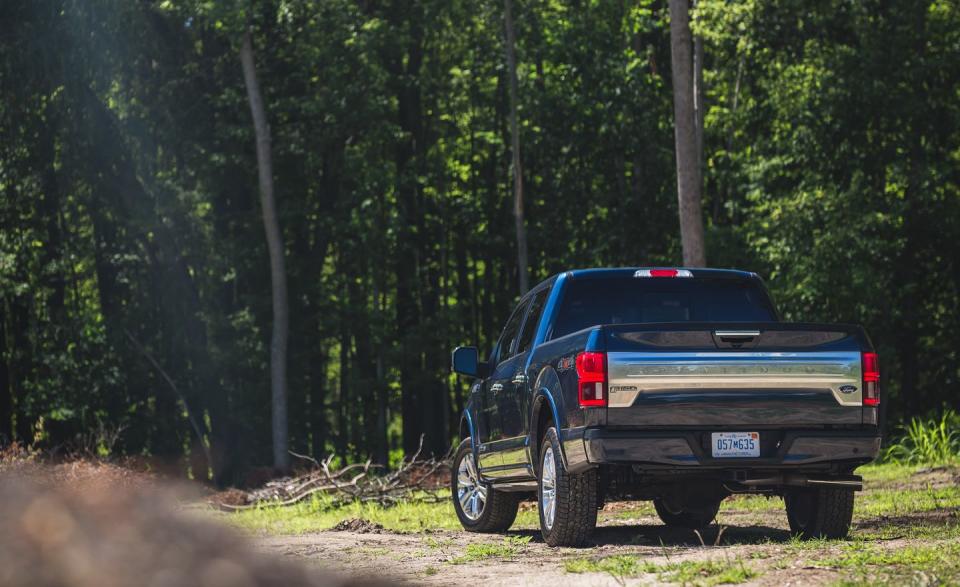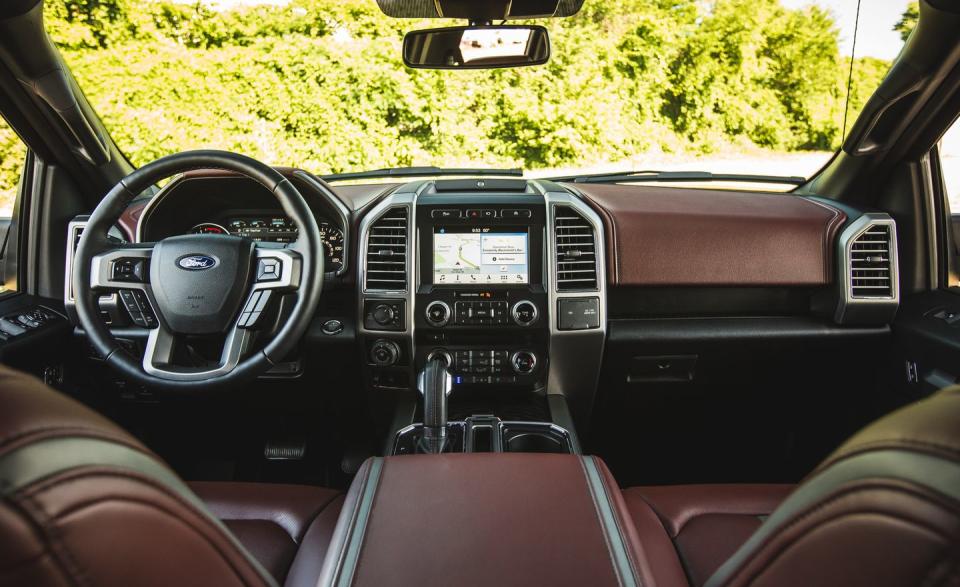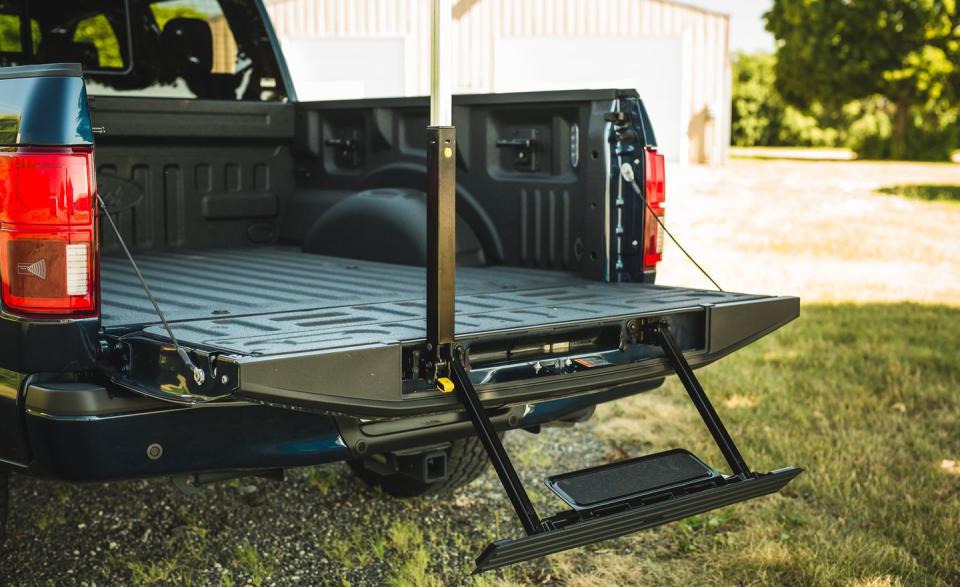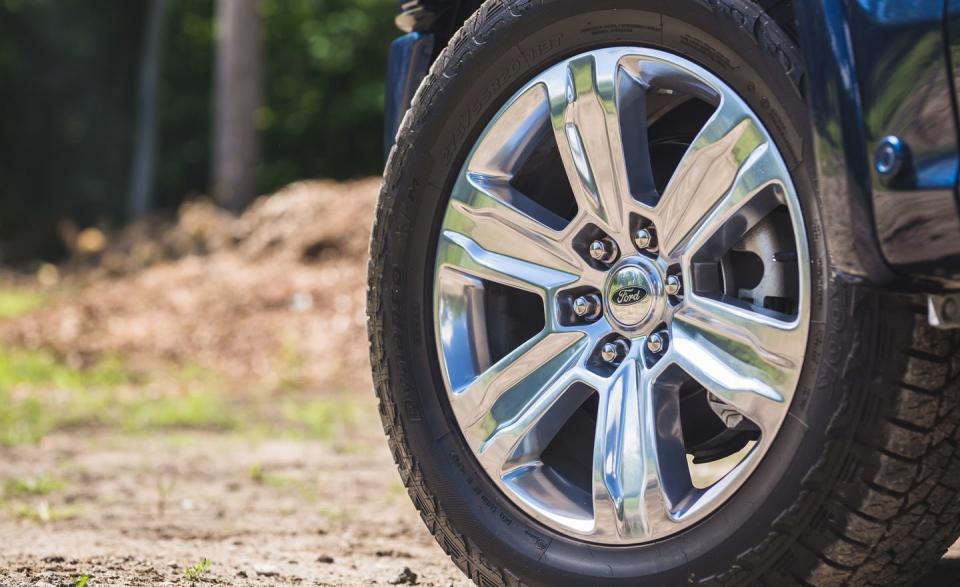2018 Ford F-150 3.0L V-6 Power Stroke Diesel

When it comes to pickup trucks, the decision to go diesel is generally simple: If you haul heavy loads and/or tow trailers on a regular basis, there is no substitute for the confidence-inspiring muscle and low-end torque of a compression-ignition engine. The incremental improvements in fuel economy that you’ll also gain just sweeten the deal. However, the Ford F-150 with its optional Power Stroke turbo-diesel 3.0-liter V-6 flips this formula on its head.
Although it now wears a Power Stroke badge, the 3.0-liter V-6 has an international pedigree. Commonly referred to as the Lion engine, it was jointly developed by Ford with PSA Peugeot Citroën years ago and is currently used in some Land Rover products. We previously detailed how Ford beefed it up for domestic truck duty, but here’s a brief refresher: The block is a compacted graphite-iron casting, and new components include a forged crankshaft with specific rod and crank bearings and a variable-geometry turbocharger. The common-rail fuel injection runs at 29,000 psi, while twin fuel filters and a dual-stage oil pump address purity and lubrication issues. Although its 250-hp figure may seem a little weak in the knees, it’s the 440 lb-ft of torque that is of interest to those who work their trucks hard. A 10-speed automatic is the sole transmission option. (Here's our complete rundown on the new engine and transmission.)
The Price of Efficiency
Ford has made some noise with the 3.0-liter diesel’s recently announced 30-mpg highway EPA fuel-economy rating (along with 22 mpg city and 25 mpg combined), but those numbers apply only to the rear-wheel-drive SuperCab. The popular SuperCrew 4x4 configuration is rated at 25 mpg highway, 20 mpg city, and 22 mpg combined-still impressive for a full-size pickup. For comparison, the 2018 Ram 1500 EcoDiesel earns a 27-mpg highway estimate for both two- and four-wheel-drive variants, but the rear-drive Ram’s 20 mpg city and 23 mpg combined ratings trail the Ford’s, as do the Ram 4x4’s 19 mpg city and 22 mpg combined. (The redesigned 2019 Ram 1500 isn’t offering the EcoDiesel during its first model year, but we expect it to return to the lineup soon.)
Going diesel comes at a price. In the Lariat trim, replacing the standard EcoBoost 2.7-liter V-6 with the 3.0-liter Power Stroke costs $4000; swapping out the King Ranch’s standard 5.0-liter V-8 with the diesel is a $3000 upcharge, a daunting proposition considering the muscular, gas-burning EcoBoost 3.5-liter V-6 can be had for a comparatively painless $600 (or $1600 on the Lariat). In the more basic XL and XLT models, the diesel is available for fleet customers only.
We strapped our test gear to a 2018 F-150 Platinum 4x4 SuperCrew. Besides the diesel engine, our truck came with a $495 spray-in bedliner, $180 wheel-well liners, the $2250 Preferred Equipment Group 701A (adaptive cruise control with stop and go, pedestrian detection, forward-collision warning, and the tailgate step with tailgate-lift assist). A trailer tow package (four-pin/seven-pin wiring harness, an auxiliary transmission-oil cooler, Class IV trailer-hitch receiver, and an upgraded front anti-roll bar) was $995, and last but not least, a 3.55:1 electronically locking rear axle was $470, which is a steal for such a crucial piece of hardware. All in, the truck cost $66,405.
Quiet by Any Measure
Forget the customary “for a diesel” qualifier, as we can say the 3.0-liter Power Stroke is just straight-up quiet. Other than a small amount of telltale diesel clatter at startup, there’s little indication that the engine within forgoes spark ignition in the process of combustion. Obviously, standing directly in front of the truck’s grille or popping the hood will reveal the engine’s true nature, but in terms of noise, vibration, and harshness at the helm, it sounds far more like a mild-mannered gasoline V-6 than a heavy hauler. Still, from the driver's seat our sound-level meter measured the diesel's warmed-up idle at 42 decibels, substantially higher than the Limited EcoBoost's 35. However, both during maximum acceleration and while cruising at 70 mph, the diesel proved quieter.
Regardless of any arguments for or against the 3.0-liter Power Stroke's financial or efficiency attributes, you'd be hard pressed to find an engine better suited for everyday-pickup duty. With all 440 lb-ft of torque on tap at a low 1750 rpm, it moves the truck out from a stop without a hint of strain. At the track, our Platinum crew cab accelerated to 60 mph in 7.7 seconds and through the quarter-mile in 16.0 seconds flat; that's quick enough, but certainly no threat to the 5.1- and 13.7-second times put down by the recently tested 2019 F-150 Limited with the 3.5-liter EcoBoost. Still, the diesel's effortless and drama-free personality recalls the stoic characteristics that defined Ford's venerated 4.9-liter inline-six from decades ago. It's ready to work and sufficiently quick for truck duty. It's also more than a second quicker than the last Ram EcoDiesel we tested.
Stopping power fell right into line with the F-series pack, with the F-150 Power Stroke requiring 177 feet to come to a halt from 70 mph. That's nine feet more than required by the aforementioned 2019 Limited, and one foot more than required by a 2018 F-150 SuperCrew with rear-wheel drive and a 5.0-liter V-8.
In addition to the truck we tested in Michigan, we also drove other variants at Ford's launch event in Colorado, including a King Ranch SuperCrew 4x4 loaded with 700 pounds of landscaping supplies in the bed. Step-off is as confident as you would expect from an engine with 440 lb-ft of torque available at just 1750 rpm and coupled to a 3.55:1 rear-axle ratio, but you don’t get the same redline-chasing rush offered by the 2.7- and 3.5-liter EcoBoost V-6s. Navigating the circuitous two-lane Highway 72 west of Broomfield to an elevation of more than 8800 feet above sea level presented little challenge for the diesel. The 10-speed automatic transmission in its Normal mode-Sport, Eco, Tow/Haul, and Off-Road modes also are available-performed almost imperceptibly. Then again, with 10 cogs to choose from, there’s not a lot of real estate in between the ratios. The ride was remarkably smooth, controlled, and quiet. Slipping the shifter into its manual mode allowed us to select a gear for optimum engine braking while rolling down the mountain; sadly, there is no exhaust brake, ruling out the possibility of indulging our inner 10-year-old with a quick and noisy game of “big rig nearly out of control” while enjoying a dance with gravity and momentum.
Later, we retraced the route in an unladen truck with the identical powertrain. As expected, the removal of 700 pounds of ballast in the bed made for a bouncier ride, but it was no livelier than any other current F-150. We switched to Sport mode and utilized a heavy foot to intentionally drive down the fuel-economy number for the duration of the approximately 22-mile trip. After lining up at traffic lights against random and completely oblivious competitors for a few impromptu rounds of Pedal to the Metal: F-150 Diesel Edition, we observed an entirely reasonable 22 mpg (indicated) for the route. Back home in Michigan, we averaged 22 mpg overall, exactly nailing the EPA combined estimate for the 4x4 SuperCrew. Even more impressive, we recorded a solid 27 mpg in our 75-mph highway loop, beating the 25-mpg EPA estimate.
As a side note, off-roading in a SuperCrew equipped with the FX4 Off-Road package had little to do with the diesel specifically other than highlighting how easy it is to modulate the load at low speeds thanks to all that low-end torque. Just maintain momentum and let the four-wheel drive and optional electronically locking rear differential earn their keep.
Finally, while still in Colorado we grabbed another King Ranch SuperCrew, this time with 6240 pounds of box trailer secured to the hitch. That’s a hefty load but nearly two tons less than this configuration’s 10,100-pound maximum tow rating. (The 11,400-pound max tow rating Ford advertises for the diesel is for regular-cab, two-wheel-drive XL models only.) This time we embarked on a different route, a 23.5-mile loop of varied terrain, driving quickly but cautiously-braking early, anticipating red lights, and maintaining the speed of traffic. This truck was equipped with the 3.31:1 rear differential, and you could feel it. As anyone who has trailered with an F-150 knows, it’s an excellent tow vehicle-it tracks straight, the sway control adds a level of safety and comfort, and it generally makes towing far easier and safer than you’d expect. But even before we hit the uphill portions of the route (we started at 5420 feet above sea level) the 3.0-liter diesel was working full time to maintain 55 mph, and moderate hills were a foot-to-the-floor affair. It’s not that we were expecting it to perform with a Super Duty level of nonchalance, but the dramatic advances in the HD arena over the past few years may have unrealistically heightened our expectations for the 3.0-liter Power Stroke.
It’s important to note that it never felt overstressed in the way a gasoline engine can when tugging a load uphill, that sensation where the vehicle slows to a degree that you begin to contemplate that you might not actually make it to the top. The Power Stroke maintains confidence all the way, loyally if not exuberantly. And it never betrays its quiet nature; the last Ram 1500 EcoDiesel we tested never let you forget a diesel was under the hood. The F-150's dashboard readout indicated 13 mpg for this trailer-towing segment.
New Math
There’s no denying that the 3.0-liter Power Stroke is a polished performer. The rub comes when you start to delve into the numbers in earnest. In addition to adjusting your fuel-economy expectations for cab and driveline variations as previously detailed, there’s the small matter that the diesel’s 11,400-pound max tow rating and 2020-pound payload rating aren’t even enough to make it the most capable workhorse in the F-150 lineup. That honor falls to a properly equipped F-150 with the 3.5-liter EcoBoost V-6 that is rated to tow 13,200 pounds and haul a 3270-pound payload. Further clouding the issue, the EcoBoost’s tow ratings are calculated running premium fuel, which closes the gap or in some cases entirely negates the price advantage gasoline can have over diesel at the pump. Considering the initial upcharge for the diesel engine, it’s a numbers game best left to be played by shoppers with sharp pencils and solid usage data.
Given the lack of a black-and-white fiscal argument for the diesel and the fact that Ford anticipates it will account for just 5 percent of all F-150 sales, we wonder if certification is the real play here. Ford confided to us earlier that the Dagenham, England, assembly facility where the 3.0-liter diesel is built has enough capacity to exceed the current demand; with both the U.S.-spec Ranger and a new Bronco waiting in the wings, it’s possible that Ford may be eyeing the engine for use in those vehicles, too.
The bottom line is that efficiency is the goal here, not pulling-power supremacy. If you frequently tow a moderate amount over long distances, say a pair of snowmobiles or ATVs, or a utility trailer under 5000 pounds-and occasionally tackle a short-haul, 7000-pound-plus towing job-the 3.0-liter Power Stroke diesel will provide plenty of quiet power and theoretically improved fuel economy over the long run. But buyers who regularly tow more than 6500 pounds would be better served by the 3.5-liter EcoBoost or, should they make a habit of heavy hauling, a Super Duty. On the other hand, if a strong silent type with a unique powertrain tickles your fancy above all, the F-150 Power Stroke may be just the ticket.
('You Might Also Like',)

 Yahoo Finance
Yahoo Finance 





